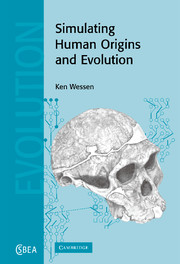11 - Simulating multiple populations
Published online by Cambridge University Press: 14 August 2009
Summary
Adding migrations to the simulation opens up a huge number of further possibilities for investigation. However, rather than attempt an exhaustive coverage, the results in this chapter will instead only cover a handful of particular cases. Less emphasis will be placed on average results than in the previous chapter, since they tend to smooth over and thus obscure many of the more interesting outcomes. Instead, single runs will primarily be discussed, and the impact of migrations examined.
Sample simulation with regular migrations
In order to provide an illustrative example, the runs presented in this section involved regular replacement migrations (see Section 9.1) between three relatively small populations, and ran for only 200 generations. However, some of the additional features of the model, specifically infidelity and nonzero chance of variously sized disasters, were added. The precise settings employed included population size constraints of 40 individuals at generation 10 increasing exponentially to 100 individuals by generation 200, an average fertility rate of 3.5 children and reproduction chance of 90% for the females in the population, and infidelity rates of 20% for males and 10% for females. Constant across all three populations was a 10% chance for a replacement migration involving 10% of the population, and there was also a 10% chance of a small disaster, 5% of a medium disaster and 1% of a large one.
- Type
- Chapter
- Information
- Simulating Human Origins and Evolution , pp. 186 - 200Publisher: Cambridge University PressPrint publication year: 2005



